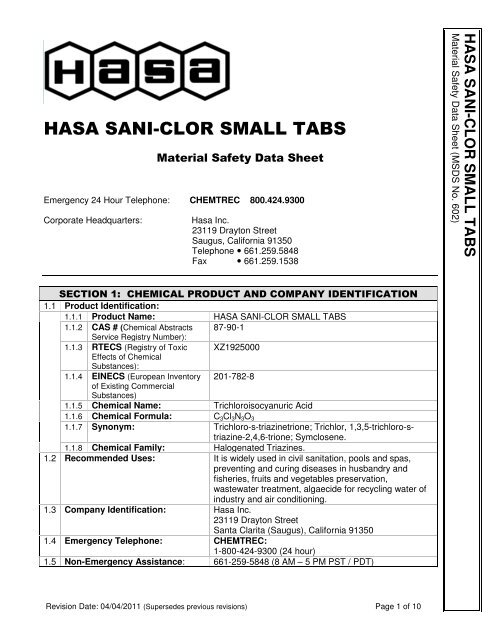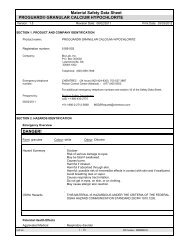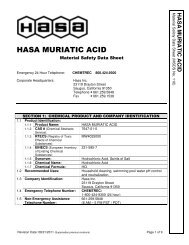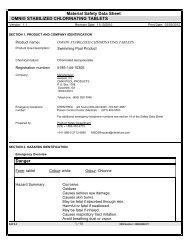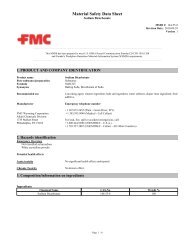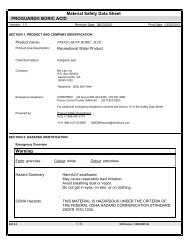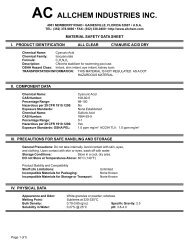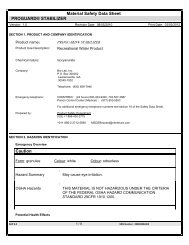HASA SANI-CLOR SMALL TABS - B's Pool Supplies
HASA SANI-CLOR SMALL TABS - B's Pool Supplies
HASA SANI-CLOR SMALL TABS - B's Pool Supplies
Create successful ePaper yourself
Turn your PDF publications into a flip-book with our unique Google optimized e-Paper software.
<strong>HASA</strong> <strong>SANI</strong>-<strong>CLOR</strong> <strong>SMALL</strong> <strong>TABS</strong><br />
Material Safety Data Sheet<br />
Emergency 24 Hour Telephone: CHEMTREC 800.424.9300<br />
Corporate Headquarters: Hasa Inc.<br />
23119 Drayton Street<br />
Saugus, California 91350<br />
Telephone � 661.259.5848<br />
Fax � 661.259.1538<br />
SECTION 1: CHEMICAL PRODUCT AND COMPANY IDENTIFICATION<br />
1.1 Product Identification:<br />
1.1.1 Product Name: <strong>HASA</strong> <strong>SANI</strong>-<strong>CLOR</strong> <strong>SMALL</strong> <strong>TABS</strong><br />
1.1.2 CAS # (Chemical Abstracts<br />
Service Registry Number):<br />
87-90-1<br />
1.1.3 RTECS (Registry of Toxic<br />
Effects of Chemical<br />
Substances):<br />
XZ1925000<br />
1.1.4 EINECS (European Inventory<br />
of Existing Commercial<br />
Substances)<br />
201-782-8<br />
1.1.5 Chemical Name: Trichloroisocyanuric Acid<br />
1.1.6 Chemical Formula: C3Cl3N3O3<br />
1.1.7 Synonym: Trichloro-s-triazinetrione; Trichlor, 1,3,5-trichloro-striazine-2,4,6-trione;<br />
Symclosene.<br />
1.1.8 Chemical Family: Halogenated Triazines.<br />
1.2 Recommended Uses: It is widely used in civil sanitation, pools and spas,<br />
preventing and curing diseases in husbandry and<br />
fisheries, fruits and vegetables preservation,<br />
wastewater treatment, algaecide for recycling water of<br />
industry and air conditioning.<br />
1.3 Company Identification: Hasa Inc.<br />
23119 Drayton Street<br />
Santa Clarita (Saugus), California 91350<br />
1.4 Emergency Telephone: CHEMTREC:<br />
1-800-424-9300 (24 hour)<br />
1.5 Non-Emergency Assistance: 661-259-5848 (8 AM – 5 PM PST / PDT)<br />
Revision Date: 04/04/2011 (Supersedes previous revisions) Page 1 of 10<br />
<strong>HASA</strong> <strong>SANI</strong>-<strong>CLOR</strong> <strong>SMALL</strong> <strong>TABS</strong><br />
Material Safety Data Sheet (MSDS No. 602)
SECTION 2: EMERGENCY OVERVIEW and HAZARD IDENTIFICATION<br />
2.1 Emergency Overview Danger! Strong oxidizer. Contact with combustibles may cause<br />
fire. Contact with acids may liberate hazardous gases. Toxic to<br />
aquatic organisms. Hygroscopic. Absorbs water from atmosphere.<br />
Do not take internally. Avoid contact with eyes, skin and clothing.<br />
Upon contact with skin or eyes, wash off with water. Avoid<br />
breathing dust. Store in a clean, cool, dry well –ventilated area. Do<br />
not store at temperatures above 60 o C (140 o F). This pesticide is<br />
toxic to fish and aquatic organisms.<br />
2.2 Acute Health Effects<br />
2.2.1 Eyes Severe irritation and/or burns can occur following eye exposure.<br />
Contact may cause impairment of vision and corneal damage.<br />
2.2.2 Skin Dermal exposure can cause severe irritation and /or burns<br />
characterized by redness, swelling and scab formation. Repeated<br />
skin exposure may cause tissue destruction due to the corrosive<br />
nature of the product.<br />
2.2.3 Inhalation This material in the form as sold is not expected to produce<br />
respiratory effects. Particles of respirable size are generally not<br />
encountered. The respirable fraction is typically less than 0.1% by<br />
weight for the granular and extra granular grades. If ground or<br />
otherwise in a powdered form, effects similar to a corrosive<br />
substance may occur. May cause severe irritation of the<br />
respiratory tract with coughing, choking, pain and possibly burns of<br />
the mucous membranes. If significant or prolonged exposure<br />
occurs, pulmonary edema may develop, either immediately or<br />
more often within a period of 5-72 hours. The symptoms may<br />
include tightness in the chest, dyspnea, sputum, cyanosis, and<br />
dizziness. Physical findings may include moist rales, low blood<br />
pressure and high pulse pressure. Severe causes may be fatal.<br />
2.2.4 Ingestion Irritation and/or burns can occur to the entire gastrointestinal tract,<br />
including the stomach and intestines, characterized by nausea,<br />
vomiting, diarrhea, abdominal pain, bleeding and/or tissue<br />
ulceration. Ingestion causes severe damage to the gastrointestinal<br />
2.2.5 Medical<br />
Conditions<br />
Aggravated By<br />
Exposure:<br />
2.3 Chronic Health<br />
Effects<br />
tract with the potential to cause perforation.<br />
Asthma, respiratory and cardiovascular disease.<br />
May cause liver and kidney damage.<br />
Prolonged exposure may cause damage to the respiratory system.<br />
Chronic inhalation exposure may cause impairment of lung<br />
function and permanent lung damage.<br />
SECTION 3: COMPOSITION INFORMATION ON INGREDIENTS<br />
Ingredient CAS No. Approx. Wt.%<br />
3.1 Trichloroisocyanuric Acid 89-90-1 96.0 - 100.0%<br />
3.2 Dichloroisocyanuric Acid 2893-78-9 0.4%<br />
Revision Date: 04/04/2011 (Supersedes previous revisions) Page 2 of 10<br />
<strong>HASA</strong> <strong>SANI</strong>-<strong>CLOR</strong> <strong>SMALL</strong> <strong>TABS</strong><br />
Material Safety Data Sheet (MSDS No. 602)
SECTION 4: FIRST AID MEASURES<br />
4.1. IF IN EYES • Hold eye open and rinse slowly and gently with water for 15-20 minutes.<br />
• Remove contact lenses, if present, after the first 5 minutes, then continue<br />
rinsing eye.<br />
4.2. IF ON SKIN OR<br />
CLOTHING<br />
• Call a poison control center or doctor for treatment advice.<br />
• Take off contaminated clothing.<br />
• Rinse skin immediately with plenty of water for 15-20 minutes.<br />
• Call a poison control center or doctor for treatment advice.<br />
4.3. IF INHALED • Move person to fresh air.<br />
• If person is not breathing, call 911 or an ambulance, then give artificial<br />
respiration, preferably mouth-to-mouth if possible.<br />
• Call a poison control center or doctor for further treatment advice.<br />
4.4. IF SWALLOWED • Call a poison control center or doctor immediately for treatment advice.<br />
• Have person sip a glass of water if able to swallow.<br />
• Do not induce vomiting unless told to do so by a poison control center or<br />
doctor.<br />
• Do not give anything by mouth to an unconscious person.<br />
HOT LINE NUMBER<br />
Have the product container or label with you when calling a poison control center or doctor, or<br />
going for treatment. You may also contact 1-800-424-9300 for emergency medical treatment<br />
information.<br />
NOTE TO PHYSICIAN<br />
Probable mucosal damage may contraindicate the use of gastric lavage.<br />
5.1 Extinguishing<br />
Media:<br />
5.2 Fire/Explosion<br />
Hazards:<br />
5.3 Fire Fighting<br />
Procedures:<br />
SECTION 5: FIRE FIGHTING MEASURES<br />
Use water spray, dry chemical, carbon dioxide or chemical foam. Contact<br />
professional fire fighters immediately. Do not use fire extinguishers containing<br />
ammonium compounds or carbon tetrachloride.<br />
Negligible fire hazard. If heated by outside sources above 240 o C (464 o F) this<br />
product will undergo decomposition with the evolution of noxious gases but no<br />
visible flame. Wet materials may generate nitrogen trichloride and explosion<br />
hazard.<br />
Wear a self-contained breathing apparatus in pressure-demand, MSHA/NIOSH<br />
approved (or equivalent), and full protective gear. Strong oxidizer. Contact with<br />
combustible materials may cause a fire. During a fire, irritating and highly toxic<br />
gases may be generated by thermal decomposition or combustion. Use water<br />
with caution and in flooding amounts. Contact with acid or acid fumes evolves<br />
heat and flammable vapors. Some oxidizers may react explosively with<br />
hydrocarbons (fuel). May accelerate burning if involved in a fire. Containers may<br />
explode when heated. Extinguishing media: Contact professional fire-fighters<br />
immediately. For small fires DO NOT use dry chemicals, carbon dioxide, halon<br />
or foams. USE WATER ONLY. For large fires flood fire with water from a<br />
distance.<br />
5.4 Flammable Limits: No information available<br />
5.5 Products of When heated to decomposition it emits very toxic fumes of chlorine and<br />
Combustion: nitrogen oxides.<br />
5.6 Fire Hazards in Do not mix with other chemicals. Keep combustibles away from this product.<br />
Presence of<br />
Various<br />
Substances:<br />
5.7 Sensitivity to Not sensitive.<br />
Impact or Static<br />
Discharge:<br />
Revision Date: 04/04/2011 (Supersedes previous revisions) Page 3 of 10<br />
<strong>HASA</strong> <strong>SANI</strong>-<strong>CLOR</strong> <strong>SMALL</strong> <strong>TABS</strong><br />
Material Safety Data Sheet (MSDS No. 602)
SECTION 6: ACCIDENTAL RELEASE MEASURES<br />
Use proper personal protective equipment. (See section 8 below). Vacuum or sweep up material<br />
and use beneficially or place in a suitable disposal container. Avoid generating dusty conditions.<br />
Provide ventilation. Do not use combustible materials such as paper towels to clean up spill. Keep<br />
combustibles, wood, paper, oil, sweeping compounds away from spilled material. Do not let<br />
chemical enter environment. If material has been contaminated, fill disposal container with water.<br />
Do not seal container. Do not add water to spilled materials. Do not store or transport wet materials,<br />
call <strong>HASA</strong> for additional information and advice.<br />
SECTION 7: HANDLING AND STORAGE<br />
7.1 Handling: Danger! Corrosive! Causes irreversible eye damage. Harmful if swallowed<br />
or absorbed through skin. Do not get on skin, in eyes or on clothing. Wear<br />
safety glasses goggles, or face shield, protective clothing, and rubber gloves<br />
when handling this product. Wash thoroughly with soap and water after<br />
handling and before eating, drinking, chewing gum, using tobacco, or using<br />
the toilet. Remove and wash contaminated clothing before reuse. Irritating to<br />
nose and throat. Avoid breathing dust.<br />
7.2 Storage: Keep this product dry in a tightly closed container, when not in use.<br />
Store in a cool, dry well-ventilated area away from heat and open flames.<br />
In case of contamination or decomposition do not reseal container, If<br />
possible, isolate container in open air or well-ventilated area and flood with<br />
large quantities of water, if necessary.<br />
Do not contaminate water, food, or feed by storage, disposal, or cleaning of<br />
7.3 Additional<br />
Information:<br />
equipment.<br />
Wastes resulting from the use of this product must be disposed of on site or<br />
at an approved waste disposal facility. For product that cannot be used, call<br />
your local solid waste agency for disposal instructions. Never place unused<br />
product down any indoor or outdoor drain.<br />
SECTION 8: EXPOSURE CONTROLS / PERSONAL PROTECTION<br />
8.1 Engineering Controls: Local exhaust ventilation.<br />
8.2 Personal Protection:<br />
8.2.1 Eyes and Face: Wear chemical safety goggles plus full face shield to<br />
protect against splashing when appropriate.<br />
8.2.2 Skin: Wear impervious gloves such as rubber, neoprene or vinyl.<br />
8.2.3 Respiratory: NIOSH/MSHA approved respirator. Manufacturer's<br />
recommendations should be followed as a precautionary<br />
measure where airborne contaminants may occur.<br />
8.2.4 Clothing: Wear impervious protective clothing including rubber safety<br />
shoes. Eye wash facility and emergency shower should be<br />
in close proximity.<br />
8.3 Additional Information: No additional information found<br />
Revision Date: 04/04/2011 (Supersedes previous revisions) Page 4 of 10<br />
<strong>HASA</strong> <strong>SANI</strong>-<strong>CLOR</strong> <strong>SMALL</strong> <strong>TABS</strong><br />
Material Safety Data Sheet (MSDS No. 602)
SECTION 9: PHYSICAL AND CHEMICAL PROPERTIES<br />
9.1 Physical State and Appearance: White tablets (1” diameter)<br />
9.2 Odor: Slight odor of chlorine.<br />
9.3 Odor Threshold: Not reported.<br />
9.4 Molecular Weight: 232.4 g/mole<br />
9.5 Boiling Point: Not applicable<br />
9.6 Melting Point: 246.7 o C (decomposes)<br />
9.7 Solubility in Water: 12g/L @ 25 o C<br />
9.8 pH: 2.7 to 3.3 (1% aqueous solution)<br />
9.9 Bulk Density: 1.16-1.9 g/cc<br />
9.10 Vapor Density: Not applicable.<br />
9.11 Vapor Pressure: Very small, impossible to measure.<br />
9.12 Evaporation Rate: Not applicable.<br />
9.13 Flash point: > 250 o C (482 o F) open cup.<br />
9.14 Flammability: Not applicable.<br />
9.15 Flammable Limits: Not applicable.<br />
9.16 Percent Volatile: Not applicable.<br />
9.17 Auto Ignition Temperature: Not applicable.<br />
9.18 Coefficient of Oil/Water<br />
Distribution:<br />
Not applicable.<br />
SECTION 10: STABILITY AND REACTIVITY<br />
10.1 Stability: Hygroscopic. Absorbs water from atmosphere.<br />
Thermally unstable.<br />
10.2 Conditions to Avoid: Do not package in paper or cardboard. Note: Contact<br />
with small amounts of water may result in an<br />
exothermic reaction with the liberation to toxic fumes.<br />
10.3 Polymerization: Will not occur.<br />
10.4 Incompatible Materials: Organic materials, reducing agents, nitrogen<br />
containing materials, other oxidizers, acids, bases,<br />
oils, grease, sawdust, dry fire extinguishers containing<br />
10.5 Hazardous Decomposition<br />
Products:<br />
monoammonium compounds.<br />
Nitrogen trichloride, chlorine, nitrous oxides, cyanates,<br />
carbon monoxide, carbon dioxide.<br />
Revision Date: 04/04/2011 (Supersedes previous revisions) Page 5 of 10<br />
<strong>HASA</strong> <strong>SANI</strong>-<strong>CLOR</strong> <strong>SMALL</strong> <strong>TABS</strong><br />
Material Safety Data Sheet (MSDS No. 602)
SECTION 11: TOXICOLOGICAL INFORMATION<br />
11.1 Routes of Entry: Eyes, skin, ingestion, dermal absorption.<br />
11.2 Acute Toxicity:<br />
Test Animals<br />
(EPA Reregistration Eligibility<br />
Document)*<br />
Results with<br />
Trichloroisocyanuarte<br />
Toxicity category<br />
11.2.1 Eye Irritation* (rabbit): Very irritating I<br />
11.2.2 Dermal Irritation* (rabbit): Mild irritation. III<br />
11.2.3 Dermal* LD50 (rabbit): >10 g/kg III<br />
11.2.4 Oral* LD50 (rat): 1500 mg/kg III<br />
11.2.5 Inhalation LC50 (rat): 0.09-0.29 mg/L 4 hours<br />
11.3 Target Organs: Kidneys, liver, respiratory systems, eyes, skin.<br />
11.4 Acute Effects from Overexposure: No information found.<br />
11.5 Chronic Effects from Overexposure: Prolonged exposure may cause damage to the<br />
respiratory system. Chronic inhalation exposure<br />
may cause impairment of lung function and<br />
permanent lung damage.<br />
11.6 Carcinogenic [Cancer Potential] Information:<br />
11.6.1 NTP (National Toxicological<br />
Program 6 th Annual Report on<br />
Carcinogens):<br />
11.6.2 IARC (International Agency for<br />
Research on Cancer Monographs,<br />
V. 1-100):<br />
Not Listed.<br />
Not Listed.<br />
11.6.3 OSHA Not Listed.<br />
11.6.4 Proposition 65, California only: (Safe Drinking Water and Toxic Enforcement Act of<br />
1986):<br />
Small quantities – less than 100 ppm (parts per million) – of impurities, including<br />
bromates, may be found in all chlorinating products, including this product. Bromates<br />
are derived from bromides, which are present in sodium chloride (table salt) from<br />
which chlorine is manufactured. Additional small quantities of bromates may be<br />
generated during the disinfection process. Bromates are known by the State of<br />
California to cause cancer when administered by the oral (drinking or ingesting) route.<br />
Read and follow label directions and use care when handling or using this product.<br />
The US Environmental Protection Agency has established a maximum contaminant<br />
level (MCL) for bromates in drinking water at 10 ppb (parts per billion). Application of<br />
this product in accordance with label directions at use dilution will not exceed this<br />
level.<br />
This warning is provided pursuant to Proposition 65, the Safe Drinking Water and<br />
Toxic Enforcement act of 1986, Chapter 6.6 of the California Health and Safety Code,<br />
which requires the Governor of California to publish a list of chemicals “known to the<br />
state to cause cancer or reproductive toxicity.” This list is compiled in accordance with<br />
the procedures established under the proposition, and can be obtained on the<br />
internet from California’s Office of Environmental Health Hazard Assessment at<br />
http://www.oehha.ca.gov. There are over 700 chemical substances on this list.<br />
Revision Date: 04/04/2011 (Supersedes previous revisions) Page 6 of 10<br />
<strong>HASA</strong> <strong>SANI</strong>-<strong>CLOR</strong> <strong>SMALL</strong> <strong>TABS</strong><br />
Material Safety Data Sheet (MSDS No. 602)
12.1 Ecotoxicological<br />
Information.<br />
SECTION 12: ECOLOGICAL INFORMATION<br />
This product is toxic to fish and aquatic organisms. Do not<br />
contaminate water by cleaning of equipment or disposal of wastes.<br />
Do not discharge effluent containing this product into lakes,<br />
streams, ponds, estuaries, oceans, or other waters unless in<br />
accordance with the requirements of a National Pollutant<br />
Discharge Elimination System (NPDES) permit and the permitting<br />
authority has been notified in writing prior to discharge. Do not<br />
discharge effluent containing this product to sewer systems without<br />
previously notifying the local sewage treatment plant authority. For<br />
guidance, contact your State Water board or Regional Office of the<br />
EPA.<br />
12.2 Aquatic Organisms:<br />
12.2.1 Fish (LC50) 0.23-0.40 mg/L blue gill sunfish (96 hour)<br />
0.24-0.37 mg/L rainbow trout (96 hour)<br />
12.2.2 Invertebrate 0.19 mg/L daphnia magna (48 hour).<br />
(LC50)<br />
12.2.3 Marine 0.09 mg/L shrimp (96 hour)<br />
Organism<br />
(LC50)<br />
12.2.4 Avian (LD50) 1890 mg/kg mallard duck (oral)<br />
1674 mg/kg Bobwhite Quail (oral)<br />
12.3 Chemical Fate: No information found<br />
SECTION 13: DISPOSAL CONSIDERATIONS<br />
13.1 Small Spill: Sweep up and use in pool or spa, if possible. DO NOT add water to spilled<br />
materials. DO NOT use floor sweeping compounds to clean up spills. Sweep<br />
and scoop spilled material into clean, Dedicated equipment. Every attempt<br />
should be made to avoid mixing spilled material with other chemicals or<br />
debris when cleaning up. DO NOT attempt to reseal contaminated drums.<br />
DO NOT transport wet or damp material. Damp material should be<br />
neutralized to a non-oxidizing state. Contact <strong>HASA</strong> for instructions for<br />
handling and disposal of damp material. Keep out of water supplies and<br />
sewers.<br />
13.2 Large Spill: Keep unnecessary people away, isolate hazard area and deny entry. DO<br />
NOT add water to spilled materials. DO NOT use floor sweeping compounds<br />
to clean up spills. Sweep and scoop spilled material into clean, dedicated<br />
equipment. Every attempt should be made to avoid mixing spilled materials<br />
with other chemicals or debris when cleaning up. DO NOT attempt to reseal<br />
contaminated drums. DO NOT transport wet of damp material. Damp<br />
material should be neutralized to a non-oxidizing state. Contact <strong>HASA</strong> for<br />
instructions for handling and disposal of damp material. Keep out of water<br />
supplies and sewers. Releases should be reported, if required, to<br />
13.3 Personal<br />
Protection:<br />
appropriate agencies.<br />
See section 8, Exposure Controls and Personal Protection.<br />
Revision Date: 04/04/2011 (Supersedes previous revisions) Page 7 of 10<br />
<strong>HASA</strong> <strong>SANI</strong>-<strong>CLOR</strong> <strong>SMALL</strong> <strong>TABS</strong><br />
Material Safety Data Sheet (MSDS No. 602)
SECTION 14: TRANSPORT INFORMATION<br />
14.1 US D.O.T.<br />
Inside packages up to Inside or individual packages<br />
2.2 pounds.<br />
over 2.2 pounds.<br />
14.1.1 Proper Shipping Name: Consumer Commodity Trichloroisocyanuric Acid. Dry<br />
14.1.2 Hazard Class /<br />
Division:<br />
ORM-D 5.1<br />
14.1.3 UN ID Number: Not applicable UN2468<br />
14.1.4 Labels: ORM-D Oxidizer 5.1<br />
14.1.5 Placards: None required Oxidizer 5.1<br />
14.1.6 Markings: None required Oxidizer 5.1<br />
14.1.7 Packing Group: None required II<br />
14.2 “Materials of Trade” Exceptions. Under certain conditions, spa and pool maintenance chemicals<br />
may be loaded into pool service and builders trucks and shipped as a MOT, not subject to DOT<br />
regulations. A MOT means a hazardous material, other than a hazardous waste, that is carried on a<br />
motor vehicle – by a private motor carrier in direct support of his/her principal business that is other<br />
than transportation by motor vehicle.<br />
To qualify as a MOT, the hazardous material must fit into any one of the following classes or divisions<br />
(but not limited to) Corrosive Materials (Class 8) or Consumer Commodities (ORM-D).<br />
Quantity Limit for MOT: For Corrosive Materials (Class 8) that belongs to Packing Group II or III, or<br />
is a consumer commodity (ORM-D) – the maximum amount of material in each package is 30 kg (66<br />
lbs) for solids, or 30 L (8 gal) for liquids. The aggregate gross weight of all MOTs on a motor vehicle<br />
may not exceed 200 kg (440 pounds).<br />
Packaging requirement:<br />
1. Packagings must be leak tight for liquids and gases, sift proof for solids, and be securely closed,<br />
secured against shifting, and protected against damage.<br />
2. Each material must be packaged in the manufacturer's original packaging, or a packaging of equal<br />
or greater strength and integrity.<br />
3. Outer packagings are not required for receptacles (e.g., cans and bottles) that are secured against<br />
shifting in cages, carts, bins, boxes or compartments.<br />
Hazard communication:<br />
• A non-bulk packaging other than a cylinder (including a receptacle transported without an outer<br />
packaging) must be marked with a common name or proper shipping name to identify the material<br />
it contains, including the letters “RQ” if it contains a reportable quantity of a hazardous substance.<br />
• The operator of a motor vehicle that contains a material of trade must be informed of the presence<br />
of the hazardous material (including whether the package contains a reportable quantity) and must<br />
be informed of the requirements of 49 CFR §173.6.<br />
Other exceptions: A MOT may be transported on a motor vehicle under the provisions of 49 CFR<br />
§173.6 (e) with other hazardous materials without affecting its eligibility for these exceptions.<br />
The MOTs regulations do not require:<br />
• shipping papers;<br />
• emergency response information;<br />
• placarding; or<br />
• formal training or retention of training records.<br />
14.3 Non “Material of Trade”. Shipments not exempt from DOT HAZMAT requirements as “Materials<br />
of Trade” must be handled, loaded, and shipped as “hazardous materials”. Hazardous materials<br />
shipments are subject to DOT regulations and require that each employee who handles these<br />
materials to be trained and qualified as a “HAZMAT employee” and his employer becomes a<br />
“HAZMAT employer”.<br />
14.4 Canadian TDG (Transportation of Dangerous Goods)<br />
14.4.1 Shipping Name: Trichloroisocyanuric acid, dry<br />
14.4.2 UN ID Number: UN2468<br />
14.4.3 Hazard Class: 5.1<br />
14.4.4 Packing Group: II<br />
Revision Date: 04/04/2011 (Supersedes previous revisions) Page 8 of 10<br />
<strong>HASA</strong> <strong>SANI</strong>-<strong>CLOR</strong> <strong>SMALL</strong> <strong>TABS</strong><br />
Material Safety Data Sheet (MSDS No. 602)
SECTION 15: REGULATORY INFORMATION<br />
15.1 U.S. Regulations:<br />
15.1.1 OSHA HAZCOM (Hazard<br />
This material is considered hazardous by the<br />
Communication)<br />
HAZCOM Standard (29 CFR 1910.1200)<br />
15.1.2 OSHA PSM (Process Safety Not regulated under PSM Standard (29 CFR<br />
Management)<br />
1910.119)<br />
15.1.3 EPA FIFRA (Federal Insecticide, EPA Reg. No. :10897-8<br />
Fungicide and Rodenticide Act) (Registered pesticide under 40 CFR 152.10)<br />
15.1.4 EPA EPCRA (Emergency Planning Section 302 – TPQ: not listed.<br />
and Community Right-to-Know Act) Section 304 - RQ: not listed.<br />
Section 313 – not on TRI list.<br />
15.1.5 EPA SARA (Superfund Amendments Section 311/312<br />
and Reauthorization Act) Title III: Acute: Yes<br />
Chronic: No<br />
Fire: Yes<br />
Reactive: Yes<br />
Sudden Release: No<br />
15.1.6 EPA TSCA (Toxic Substance Control All components are listed or exempted.<br />
Act)<br />
TSCA 12(b): This product is not subject to<br />
export notification.<br />
15.1.7 EPA CERCLA (Comprehensive 102a/103 Not regulated<br />
Environmental Response,<br />
Compensation, and Liability Act)<br />
15.1.8 EPA RMP (Risk Management Plan) Not listed. (40 CFR 68.130)<br />
15.1.9 EPA RCRA (Resource Conservation If this product becomes a waste, it meets the<br />
and Recovery Act):<br />
criteria of a hazardous waste as defined<br />
under 40 CFR 261 and would have the EPA<br />
hazardous waster number: D001.<br />
15.1.10 FHSA (Federal Hazardous Substances Complies.<br />
Act):<br />
15.2 State of California Regulations:<br />
15.2.1 CDPR (California Department of Reg. No.10897-8-ZC<br />
Pesticide Regulation)<br />
15.2.2 California RMP (Risk Management Not listed.<br />
Program)<br />
15.3 Canada Regulations:<br />
15.3.1 WHMIS (Workplace Hazardous C - Oxidizing material<br />
Materials Information System) D1B - Poisonous and infectious material -<br />
Classification:<br />
Immediate and serious effects – Toxic<br />
D2B - Poisonous and infectious material -<br />
Other effects - Toxic<br />
15.3.2 WHMIS Health Effects Criteria Met D1B - Acute lethality - toxic – immediate<br />
by this Chemical:<br />
D2B - Skin irritation - toxic – other<br />
D2B - Eye irritation - toxic - other<br />
15.3.3 WHMIS Ingredient Disclosure List Included for disclosure at 1% or greater.<br />
15.3.4 DSL (Domestic Substances List) All components of this product are on the<br />
DSL.<br />
Revision Date: 04/04/2011 (Supersedes previous revisions) Page 9 of 10<br />
<strong>HASA</strong> <strong>SANI</strong>-<strong>CLOR</strong> <strong>SMALL</strong> <strong>TABS</strong><br />
Material Safety Data Sheet (MSDS No. 602)
SECTION 16: OTHER INFORMATION<br />
16.1 HMIS III (Hazardous Materials Identification System):<br />
16.1.1 HEALTH 3<br />
16.1.2 FLAMMABILITY 0<br />
16.1.3 PHYSICAL HAZARD 2<br />
16.1.4 PERSONAL PROTECTION Section 8<br />
16.2 NFPA 704 (National Fire Protection Association):<br />
16.2.1 HEALTH 2<br />
16.2.2 FLAMMABILITY 0<br />
16.2.3 INSTABILITY 1<br />
16.2.4 SPECIAL OX<br />
16.3 ANSI (American National Standards Institute):<br />
16.3.1 Hazardous Industrial Chemicals - Complies with ANSI Z400.1 – 2004.<br />
MSDS-Preparation:<br />
16.3.2 Hazardous Industrial Chemicals - Complies with ANSI Z129.1 – 2006.<br />
Precautionary Labeling:<br />
16.4 GHS (Globally Harmonized System):<br />
16.4.1 GHS Classification: Acute Toxicity Inhalation (Category 2)<br />
Acute Toxicity Oral (Category 4)<br />
16.4.2 GHS Symbol:<br />
16.4.3 GHS Signal Word: Danger<br />
16.4.4 GHS Hazard Statement: Fatal if inhaled<br />
NOTE: The information contained herein, while not guaranteed, was prepared by competent<br />
technical personnel and is true and accurate to the best of our knowledge and belief. NO<br />
WARRANTY OR GUARANTEE, express or implied, is made regarding the product performance,<br />
product stability, or as to any other condition of use, handling, transportation, and storage.<br />
Customer use, handling, transportation, and storage may involve additional safety and/or<br />
performance considerations. Our technical personnel will be happy to respond to questions<br />
regarding safe handling, storage, transportation, and use procedures. The safe handling, storage,<br />
transportation, and use procedures remain the sole responsibility of the customer. No suggestions<br />
for handling, storage, transportation, or use are intended as or to be construed as<br />
recommendations which may infringe on any existing patents or violate any Federal, State, and/or<br />
local law and/or regulation, ordinance, standard, etc. This Material Data Safety Sheet has been<br />
prepared by Hasa, Inc. according to Hazard Communication Guidelines for Compliance (OSHA<br />
3111) published by U.S. Department of Labor, Occupational Safety and Health Administration and<br />
Hasa, Inc. can rely on the information received from its suppliers and Hasa Inc. has no independent<br />
duty to analyze the chemical or evaluate the hazards of it.<br />
Revision Date: 04/04/2011 (Supersedes previous revisions) Page 10 of 10<br />
<strong>HASA</strong> <strong>SANI</strong>-<strong>CLOR</strong> <strong>SMALL</strong> <strong>TABS</strong><br />
Material Safety Data Sheet (MSDS No. 602)


